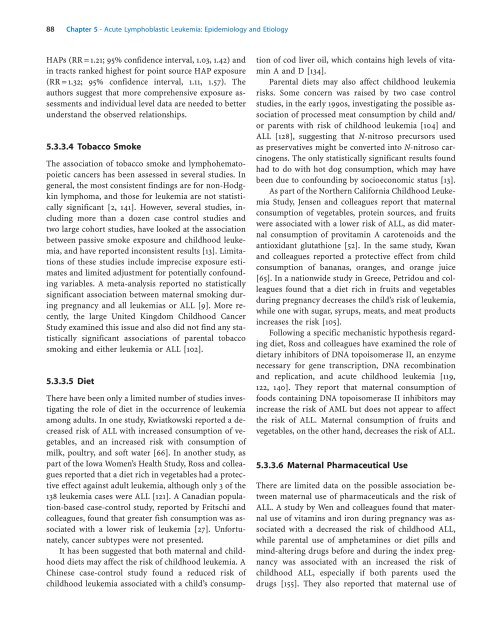Acute Leukemias - Republican Scientific Medical Library
Acute Leukemias - Republican Scientific Medical Library
Acute Leukemias - Republican Scientific Medical Library
You also want an ePaper? Increase the reach of your titles
YUMPU automatically turns print PDFs into web optimized ePapers that Google loves.
88 Chapter 5 · <strong>Acute</strong> Lymphoblastic Leukemia: Epidemiology and Etiology<br />
HAPs (RR = 1.21; 95% confidence interval, 1.03, 1.42) and<br />
in tracts ranked highest for point source HAP exposure<br />
(RR = 1.32; 95% confidence interval, 1.11, 1.57). The<br />
authors suggest that more comprehensive exposure assessments<br />
and individual level data are needed to better<br />
understand the observed relationships.<br />
5.3.3.4 Tobacco Smoke<br />
The association of tobacco smoke and lymphohematopoietic<br />
cancers has been assessed in several studies. In<br />
general, the most consistent findings are for non-Hodgkin<br />
lymphoma, and those for leukemia are not statistically<br />
significant [2, 141]. However, several studies, including<br />
more than a dozen case control studies and<br />
two large cohort studies, have looked at the association<br />
between passive smoke exposure and childhood leukemia,<br />
and have reported inconsistent results [13]. Limitations<br />
of these studies include imprecise exposure estimates<br />
and limited adjustment for potentially confounding<br />
variables. A meta-analysis reported no statistically<br />
significant association between maternal smoking during<br />
pregnancy and all leukemias or ALL [9]. More recently,<br />
the large United Kingdom Childhood Cancer<br />
Study examined this issue and also did not find any statistically<br />
significant associations of parental tobacco<br />
smoking and either leukemia or ALL [102].<br />
5.3.3.5 Diet<br />
There have been only a limited number of studies investigating<br />
the role of diet in the occurrence of leukemia<br />
among adults. In one study, Kwiatkowski reported a decreased<br />
risk of ALL with increased consumption of vegetables,<br />
and an increased risk with consumption of<br />
milk, poultry, and soft water [66]. In another study, as<br />
part of the Iowa Women’s Health Study, Ross and colleagues<br />
reported that a diet rich in vegetables had a protective<br />
effect against adult leukemia, although only 3 of the<br />
138 leukemia cases were ALL [121]. A Canadian population-based<br />
case-control study, reported by Fritschi and<br />
colleagues, found that greater fish consumption was associated<br />
with a lower risk of leukemia [27]. Unfortunately,<br />
cancer subtypes were not presented.<br />
It has been suggested that both maternal and childhood<br />
diets may affect the risk of childhood leukemia. A<br />
Chinese case-control study found a reduced risk of<br />
childhood leukemia associated with a child’s consump-<br />
tion of cod liver oil, which contains high levels of vitamin<br />
A and D [134].<br />
Parental diets may also affect childhood leukemia<br />
risks. Some concern was raised by two case control<br />
studies, in the early 1990s, investigating the possible association<br />
of processed meat consumption by child and/<br />
or parents with risk of childhood leukemia [104] and<br />
ALL [128], suggesting that N-nitroso precursors used<br />
as preservatives might be converted into N-nitroso carcinogens.<br />
The only statistically significant results found<br />
had to do with hot dog consumption, which may have<br />
been due to confounding by socioeconomic status [13].<br />
As part of the Northern California Childhood Leukemia<br />
Study, Jensen and colleagues report that maternal<br />
consumption of vegetables, protein sources, and fruits<br />
were associated with a lower risk of ALL, as did maternal<br />
consumption of provitamin A carotenoids and the<br />
antioxidant glutathione [52]. In the same study, Kwan<br />
and colleagues reported a protective effect from child<br />
consumption of bananas, oranges, and orange juice<br />
[65]. In a nationwide study in Greece, Petridou and colleagues<br />
found that a diet rich in fruits and vegetables<br />
during pregnancy decreases the child’s risk of leukemia,<br />
while one with sugar, syrups, meats, and meat products<br />
increases the risk [105].<br />
Following a specific mechanistic hypothesis regarding<br />
diet, Ross and colleagues have examined the role of<br />
dietary inhibitors of DNA topoisomerase II, an enzyme<br />
necessary for gene transcription, DNA recombination<br />
and replication, and acute childhood leukemia [119,<br />
122, 140]. They report that maternal consumption of<br />
foods containing DNA topoisomerase II inhibitors may<br />
increase the risk of AML but does not appear to affect<br />
the risk of ALL. Maternal consumption of fruits and<br />
vegetables, on the other hand, decreases the risk of ALL.<br />
5.3.3.6 Maternal Pharmaceutical Use<br />
There are limited data on the possible association between<br />
maternal use of pharmaceuticals and the risk of<br />
ALL. A study by Wen and colleagues found that maternal<br />
use of vitamins and iron during pregnancy was associated<br />
with a decreased the risk of childhood ALL,<br />
while parental use of amphetamines or diet pills and<br />
mind-altering drugs before and during the index pregnancy<br />
was associated with an increased the risk of<br />
childhood ALL, especially if both parents used the<br />
drugs [155]. They also reported that maternal use of
















